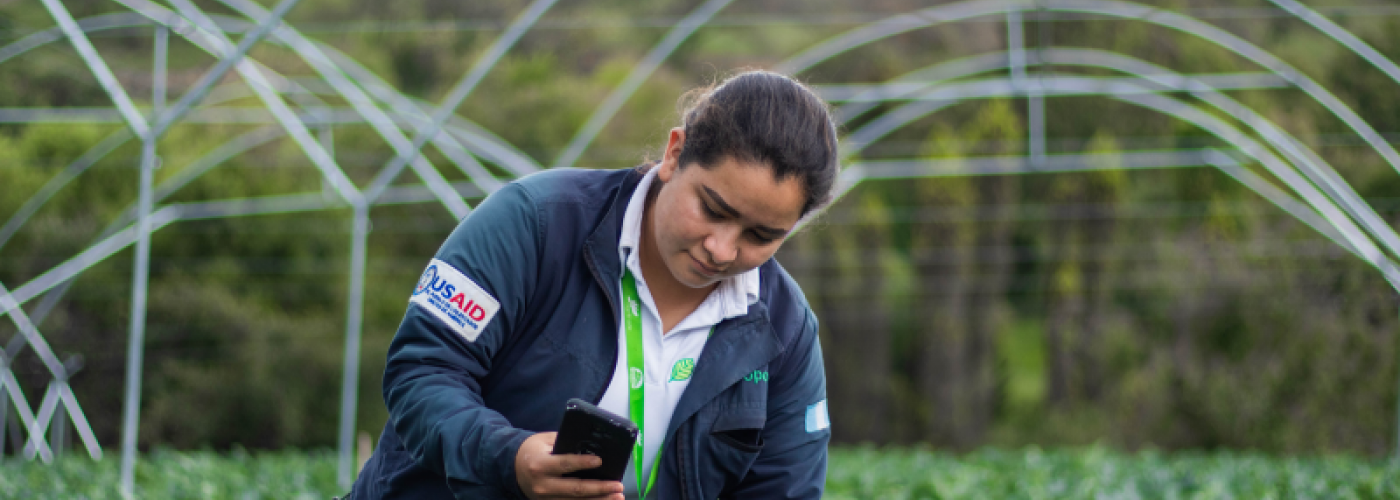From Access to Usage: Digital Financial Inclusion of Smallholder Farmers in Guatemala’s Western Highlands
Image

This post was originally published on Agrilinks and was written by Alison Harrell and Gerson Morales.
Smallholder farmers have the potential to play an increasing role in feeding the world through the sustainable supply of key agricultural commodities. However, most smallholder farmers lack funds to invest in their farms to improve productivity and connect to markets. Without inclusive market systems, smallholder farmers must rely on their own limited savings to invest in their farm, education, and other household needs which contributes to lower productivity, persistent income inequality, and slower economic growth.
Using financial inclusion to eliminate poverty
Despite the fact that Guatemala is an upper-middle-income country, almost 60 percent of the population lives in poverty. Agriculture is one of Guatemala’s main economic drivers; it has employed at least one in three Guatemalans since 2000; and in 2018, the agriculture value added was ten percent of the gross domestic product (GDP). Through the Feed the Future Initiative, led by USAID, the 2018-2022 Global Food Security Strategy (GFSS) Guatemala Country Plan serves as an overarching framework for integrated food security and nutrition programming and describes the key drivers of food insecurity, malnutrition, and poverty in Guatemala. This plan seeks to increase smallholder farmers’ access to a variety of financial services, including digital financial services (DFS).
When accessed securely and responsibly, DFS can help poor families mitigate economic shocks and build pathways out of poverty. For example, a 2016 Massachusetts Institute of Technology (MIT) and Georgetown University study showed mobile money services have had long-term effects on reducing poverty; in Kenya, it raised 194,000 households out of extreme poverty.
While access to finance in Guatemala has greatly expanded over the past few years, only 44 percent of the population has an account at a financial institution, and the vast majority of account owners reside in the greater Guatemala City area. The gap between rich and poor segments of the population with access to formal financial services is approximately 22 percent.
In May 2018, USAID's Digital Development for Feed the Future (D2FTF) team worked with the Feed the Future team in Guatemala to conduct a digital agriculture assessment. The assessment found that banks dominate Guatemala's financial sector and Mobile Network Operators (MNOs) are well positioned to serve rural populations as their agent network grows. With changing regulation and the recently launched National Strategy for Financial Inclusion in Guatemala, MNOs could play a more prominent role in the digital ecosystem going forward. Though the penetration of financial services in Guatemala is high, usage remains low. From these findings, one of the assessment recommendations was to better understand the disparities between service providers and rural clients and learn more about the customer journey of smallholder farmers.
Understanding the opportunities and risks
Given Guatemala's unique challenges, coupled with opportunities to leverage a willing banking sector, Feed the Future invested in research to understand perceptions, barriers, and enablers to serve the most vulnerable and dispersed populations in Feed the Future's zones of influence. USAID’s Center for Digital Development and MIT D-Lab's Comprehensive Initiative on Technology Evaluation (CITE) in April 2020, “Assessment of Potential Opportunities for Use of Digital Payments for Smallholder Farmers in Guatemala’s Western Highlands.”
Key findings and recommendations
There are six key findings and recommendations in the report for stakeholders in Guatemala, broken into three groups:
- Providers. Providers design and deliver DFS (i.e. banks, telecom companies, fintech startups).
- Enablers. Enablers enable a functional DFS ecosystem by managing institutions, identifying best practices, and designing regulations, policy, and programs (i.e. governments, international donors, NGOs).
- Conveners. Conveners aggregate DFS users (i.e. grassroots farmer cooperatives or farmer networks).
As a result of these findings, the research team has the following recommendations to facilitate the leap from access to the use of DFS by smallholder farmers:
- Sixty-six percent of smallholder farmers indicated they made financial decisions collaboratively with other members of their household. Recommendation: providers and enablers should consider the local context and household dynamics in designing and piloting DFS products and services.
- Financial inclusion is less prevalent than digital inclusion. Recommendation: providers, enablers, and conveners should be aware that although access to a mobile phone may remove technical barriers to engaging with DFS, they must also articulate a clear value proposition for farmers and establish trust.
- The experience smallholder farmers — especially indigenous, Ladino, and multi-racial populations — have when interacting with financial institutions may have an effect on their willingness to participate in the formal financial system. Recommendation: providers, enablers, and conveners should consider sensitivity training and alternative delivery/service options aimed at reducing bias towards farmers with an indigenous background.
- Farmers with a previous relationship with a provider they trust were more likely to adopt DFS. Recommendation: providers and enablers should generate mechanisms to better understand the local context, develop relationships with farmers, and build trust to encourage the use of DFS.
- Fifty-five percent of digital financial services (DFS) users indicated they first adopted DFS out of necessity, to pay a bill or service. Recommendation: providers and enablers can expand access to DFS by collaborating with the private sector to offer services relevant to smallholder farmers (e.g., utility companies, agricultural input firms).
- Once a farmer has an established relationship with a service provider, they adopt DFS quickly. Recommendation: providers and enablers should invest in relationships with farmers; marketing and sales strategies targeting farmers can speed up the expansion of DFS usage in the country
While these are preliminary findings, the MIT research team plans to publish academic papers containing the complete methodology and research results. To learn more about DFS in agriculture, check out USAID’s Digital Financial Services for Agriculture Guide and Toolkit for Integrating DFS into Feed the Future Programs.


